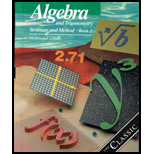
Concept explainers
(a)
To represent: The lengths of the sides of the
(a)
Answer to Problem 6P
The variables representing the lengths of the isosceles triangle are a and b.
Explanation of Solution
Given information: An isosceles triangle has perimeter 15 m.
Calculation:
It is given that the triangle is isosceles. Therefore, the triangle has two sides equal. Since the perimeter is the sum of all the sides of the triangle, the perimeter is equal to the sum of two sides having equal length and the third side.
Assume that the length of sides which have equal lengths are a and the length of the third side is b.
Hence, the variables representing the lengths of the isosceles triangle are a and b.
(b)
To write: An open sentence relating to the variables.
(b)
Answer to Problem 6P
The open sentence is
Explanation of Solution
Given information: An isosceles triangle has perimeter 15 m. The variables representing the lengths of the isosceles triangle are a and b.
Calculation:
The perimeter of the isosceles triangle is 15m. That is,
- Here, a is the length of the two sides of the triangle which have equal length and b is the length of the third side.
(b)
To write: An open sentence relating to the variables.
(b)
Answer to Problem 6P
The open sentence is
Explanation of Solution
Given information: An isosceles triangle has perimeter 15 m. The variables representing the lengths of the isosceles triangle are a and b.
Calculation:
The perimeter of the isosceles triangle is 15m. That is,
- Here, a is the length of the two sides of the triangle which have equal length and b is the length of the third side.
(c)
To solve: The open system for integral values.
(c)
Answer to Problem 6P
The only possible integral pairs are
Explanation of Solution
Given information:The open sentence is
Calculation:
The open sentence is
The variable b in terms of a is,
Choose
Choose
Choose
Choose
Choose
Choose
Choose
Choose
This is not possible as b represents the length and length cannot be negative.
Therefore, the only possible integral pairs are,
(c)
To solve: The open system for integral values.
(c)
Answer to Problem 6P
The only possible integral pairs are
Explanation of Solution
Given information:The open sentence is
Calculation:
The open sentence is
The variable b in terms of a is,
Choose
Choose
Choose
Choose
Choose
Choose
Choose
Choose
This is not possible as b represents the length and length cannot be negative.
Therefore, the only possible integral pairs are,
Chapter 3 Solutions
Algebra and Trigonometry: Structure and Method, Book 2
Additional Math Textbook Solutions
College Algebra with Modeling & Visualization (5th Edition)
Thinking Mathematically (6th Edition)
Calculus for Business, Economics, Life Sciences, and Social Sciences (14th Edition)
College Algebra (7th Edition)
A Problem Solving Approach To Mathematics For Elementary School Teachers (13th Edition)
Basic Business Statistics, Student Value Edition
- Safari File Edit View History Bookmarks Window Help Ο Ω OV O mA 0 mW ర Fri Apr 4 1 222 tv A F9 F10 DII 4 F6 F7 F8 7 29 8 00 W E R T Y U S D பட 9 O G H J K E F11 + 11 F12 O P } [arrow_forwardSo confused. Step by step instructions pleasearrow_forwardIn simplest terms, Sketch the graph of the parabola. Then, determine its equation. opens downward, vertex is (- 4, 7), passes through point (0, - 39)arrow_forward
- In simplest way, For each quadratic relation, find the zeros and the maximum or minimum. a) y = x 2 + 16 x + 39 b) y = 5 x2 - 50 x - 120arrow_forwardIn simplest terms and step by step Write each quadratic relation in standard form, then fi nd the zeros. y = - 4( x + 6)2 + 36arrow_forwardIn simplest terms and step by step For each quadratic relation, find the zeros and the maximum or minimum. 1) y = - 2 x2 - 28 x + 64 2) y = 6 x2 + 36 x - 42arrow_forward
- Write each relation in standard form a)y = 5(x + 10)2 + 7 b)y = 9(x - 8)2 - 4arrow_forwardIn simplest form and step by step Write the quadratic relation in standard form, then fi nd the zeros. y = 3(x - 1)2 - 147arrow_forwardStep by step instructions The path of a soccer ball can be modelled by the relation h = - 0.1 d 2 + 0.5 d + 0.6, where h is the ball’s height and d is the horizontal distance from the kicker. a) Find the zeros of the relation.arrow_forward
 Algebra and Trigonometry (6th Edition)AlgebraISBN:9780134463216Author:Robert F. BlitzerPublisher:PEARSON
Algebra and Trigonometry (6th Edition)AlgebraISBN:9780134463216Author:Robert F. BlitzerPublisher:PEARSON Contemporary Abstract AlgebraAlgebraISBN:9781305657960Author:Joseph GallianPublisher:Cengage Learning
Contemporary Abstract AlgebraAlgebraISBN:9781305657960Author:Joseph GallianPublisher:Cengage Learning Linear Algebra: A Modern IntroductionAlgebraISBN:9781285463247Author:David PoolePublisher:Cengage Learning
Linear Algebra: A Modern IntroductionAlgebraISBN:9781285463247Author:David PoolePublisher:Cengage Learning Algebra And Trigonometry (11th Edition)AlgebraISBN:9780135163078Author:Michael SullivanPublisher:PEARSON
Algebra And Trigonometry (11th Edition)AlgebraISBN:9780135163078Author:Michael SullivanPublisher:PEARSON Introduction to Linear Algebra, Fifth EditionAlgebraISBN:9780980232776Author:Gilbert StrangPublisher:Wellesley-Cambridge Press
Introduction to Linear Algebra, Fifth EditionAlgebraISBN:9780980232776Author:Gilbert StrangPublisher:Wellesley-Cambridge Press College Algebra (Collegiate Math)AlgebraISBN:9780077836344Author:Julie Miller, Donna GerkenPublisher:McGraw-Hill Education
College Algebra (Collegiate Math)AlgebraISBN:9780077836344Author:Julie Miller, Donna GerkenPublisher:McGraw-Hill Education





